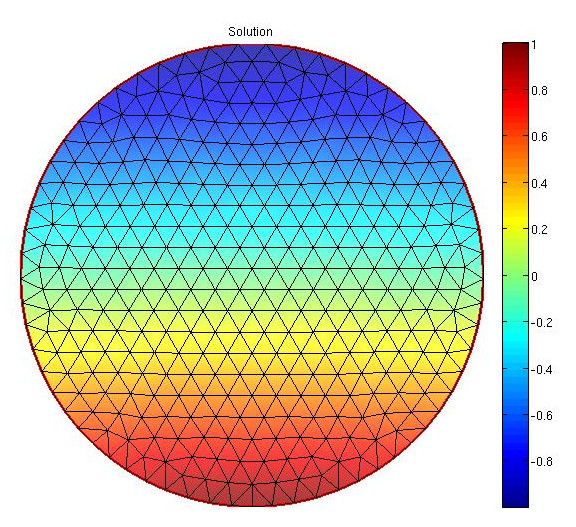I am solving the Dirichlet problem $$ \begin{cases} \Delta u = 0, \\ u|_{\partial D} = f, \end{cases} $$ in a $2d$ domain $D$ using the finite element method. What I want to get is the normal derivative of the solution $u$ on the boundary: $\tfrac{\partial u}{\partial \nu}$. In other words, I'm interested in FEM implementation of the Dirichlet-to-Neumann (Poincare-Steklov) map $\Lambda$.
Hovewer, I could not find an explicit answer to this problem in Google. I'm programming in Matlab and I would extremely appreciate an optimized solution.
I tried to solve this problem by formulating it in a weak form: find $h \in L^2(\partial D)$ such that for any $w \in H^{\frac 1 2}(\partial D)$, $$ \int_{\partial D} hw \,dl = \int_D \nabla w \nabla u dS. $$ As usually, I represent $h = \sum' h_j \psi_j$, $w = \sum w_i \psi_i$, $u = \sum u_l \psi_l$, where $\psi_i$ are the basis elements and $\sum'$ denotes summation over the boundary elements only, and I get $$ \sum_i' \sum_j' h_j w_i \int_{\partial D} \psi_i \psi_j dl = \sum_k \sum_l w_k u_l \int_D \nabla \psi_k \nabla \psi_l dS. $$ Since $\{w_j\}$ are arbitrary, we get the system $$ \sum_j' \int_{\partial D} \psi_i \psi_j dl \cdot h_j = \sum_l\int_D \nabla \psi_k \nabla \psi_l dS \, \cdot u_l. $$ Introducing the matrices $$ B_{ij} = \int_{\partial D} \psi_i \psi_j \, dl, \quad A_{ij} = \int_D \nabla \psi_i \nabla \psi_j dS, $$ where in the first matrix $i$, $j$ correspond to boundary elements and in the second matrix $i$ corresponds to the boundary elements and $j$ corresponds to all elements, I get the matrix equation $$ B h = Au, $$ for finding $h$.
However, if I implement this approach, I get some nonsense. For example, consider the following circular domain and boundary values $u_0(x,y) = -y$
Then the flux along the boundary must coincide with $u_0(x,y)$
I am trying to compute the flux of this problem with the equations used thereabove. However I was wondering what elementsfunctions to use for $h$? If I use piecewise constant on elements, I get that the $B$ matrix has rank 1 too small (because its a circle), but how can one know this beforehand? (I tried to adjoin this with that the total flux must be $0$ but it gives wrong results). If I try to use a continous at vertices and linear on elements function, I get a flux which misses a factor of $1.4$. If I try to use discontinous but linear elements the $B$ matrix has more columns then rows. For $w$ I used continous piecewise linear elements which are $1$ only at nodes on the boundary, is this right?
What is the precise elements to use for all the functions, and can someone write a pseudo code for this problem?
